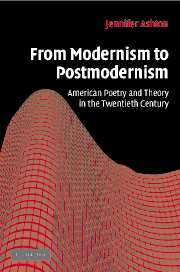Book contents
- Frontmatter
- Contents
- Acknowledgments
- Introduction: modernism's new literalism
- Chapter 1 Gertrude Stein for anyone
- Chapter 2 Making the rose red: Stein, proper names, and the critique of indeterminacy
- Chapter 3 Laura (Riding) Jackson and T=H=E N=E=W C=R=I=T=I=C=I=S=M
- Chapter 4 Modernism's old literalism: Pound, Williams, Zukofsky, and the objectivist critique of metaphor
- Chapter 5 Authorial inattention: Donald Davidson's literalism, Jorie Graham's Materialism, and cognitive science's embodied minds
- Notes
- Index
Chapter 5 - Authorial inattention: Donald Davidson's literalism, Jorie Graham's Materialism, and cognitive science's embodied minds
Published online by Cambridge University Press: 22 September 2009
- Frontmatter
- Contents
- Acknowledgments
- Introduction: modernism's new literalism
- Chapter 1 Gertrude Stein for anyone
- Chapter 2 Making the rose red: Stein, proper names, and the critique of indeterminacy
- Chapter 3 Laura (Riding) Jackson and T=H=E N=E=W C=R=I=T=I=C=I=S=M
- Chapter 4 Modernism's old literalism: Pound, Williams, Zukofsky, and the objectivist critique of metaphor
- Chapter 5 Authorial inattention: Donald Davidson's literalism, Jorie Graham's Materialism, and cognitive science's embodied minds
- Notes
- Index
Summary
LITERALISM (AGAIN)
If, as we saw in the last chapter, the problem metaphor created for poets like Ezra Pound, William Carlos Williams, and Louis Zukofsky was that it depended on “abstract terms” for analogies between “things” and thereby gave up the possibility of rendering the liveliness of “acts,” then (for Pound and Zukofsky at least) the Chinese ideograph stood as a kind of correction to metaphor through the fantasy that its “vivid shorthand pictures” dynamically transformed “things” into “acts.” And as we saw in earlier works of both Williams and Zukofsky, the effort to block the abstract exchange of meaning on which metaphor supposedly depended also took the form of literalizing “things.” Thus both Williams's transformation of his “Botticellian Trees” into the physical letters on the page and Zukofsky's transformation of the sawhorse in “‘A’-7” into a literal horse and at the same time into the letter ‘A’ that the sawhorse shape resembles are efforts to overcome metaphor that result in the very kind of literalism that would become the hallmark of language poetry in the late 1970s.
But at the same time that language poetry was just getting started, and indeed in the same year that Bruce Andrews and Charles Bernstein launched the journal L=A=N=G=U=A=G=E (1978), the philosopher Donald Davidson published an essay in Critical Inquiry called “What Metaphors Mean,” which went on to become one of the most influential and controversial accounts of metaphor in the latter half of the century.
- Type
- Chapter
- Information
- From Modernism to PostmodernismAmerican Poetry and Theory in the Twentieth Century, pp. 146 - 176Publisher: Cambridge University PressPrint publication year: 2006



